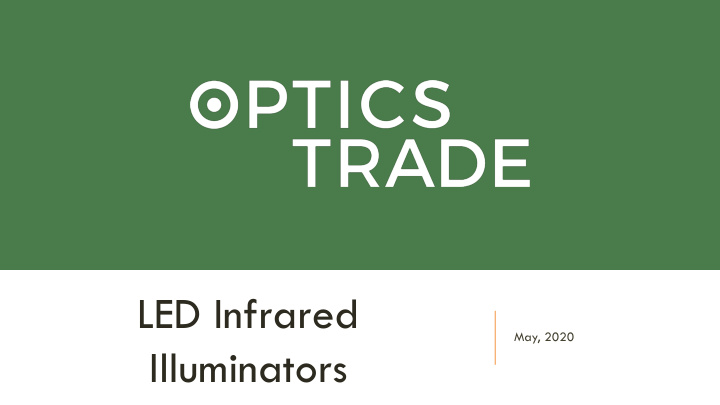



LED Infrared May, 2020 Illuminators
GENERAL FEATURES • An infrared illuminator is simply said a flashlight that emits light in an infrared spectrum • LED infrared illuminators are the most common illuminators on the market • An LED is a semiconductor light source that emits light when current flows through • LED infrared illuminators feature one or more L ight E mitting D iodes (LEDs) • Available in different wavelengths • The newer LEDs are extremely strong • LEDs almost completely replaced the older illuminators with an incandescent bulb • LEDs do not need an additional lens which lets through only the light in the infrared spectrum • LED 's can be built so that they radiate the light in a very narrow wavelength spectrum
ADVANTAGES • Small and easy to mount on a night vision device or directly on the rifle • There are some exceptions, but the bigger illuminators are designed for extreme distance observations and feature a high infrared light output • LED 's use a very small amount of energy • Are very resistant to shocks • Because the light output is not “ coherent “ , one illuminator can be used for many types of night visions • This means a LED illuminator with an advertised wavelength of 875nm radiates light from approximately 850nm up to 900nm
DISADVANTAGES • Because the light out of an LED illuminator is not “ coherent “ , this can also be a disadvantage • For example, an LED illuminator with a given wavelength of 850nm can radiate light from approximately 825nm up to 875nm. As we know, some animals can detect the light up to 850nm wavelength, so for them, it could be visible . • This is especially noticeable on cheap infrared illuminators, where the radiation has a much bigger spectrum, for example from 800nm up to 900nm. • On adjustable beam illuminators, when the light is focused on a small point for long-distance observations, the light gets a square shape
WHICH IR ILLUMINATOR FOR WHICH NIGHT VISION OPTIC • When buying an infrared illuminator, you have to be cautious what is the maximal wavelength your night vision device can detect • If the emitted light of your infrared illuminator is beyond the spectrum, it is invisible for such a device • We recommend: • For Gen. 1 NV devices an IR illuminator with a wavelength between 750nm and 780nm, • For Gen. 2 an illuminator with a wavelength of 850nm, or even higher (up to 900nm) if you own a high-quality IIT in your device • For Gen. 3 an IR illuminator is mostly not needed, but one with a wavelength of 850nm - 900nm would work perfectly • For a digital night vision device an IR illuminator with a wavelength between 850nm and 980nm
MOUNTING OF IR ILLUMINATORS • Because the most night vision devices are designed for hunting purposes, the manufacturers came up with different mounting solutions for the IR illuminators • The most common are IR illuminators with a 30mm main tube , so a normal rifle scope mounting ring can be used - this one can be then attached to the optic itself, or directly on the rifle • The most common mounting solutions on NV optics are short 11-millimeter dovetail rails or short Picatinny rails • The easiest way is to mount it on an existing Picatinny rail (if exists) • If you don ´ t have a Picatinny rail on your rifle, then a clamp-mount can be used. This can be clamped directly on your rifle scope or the rifle barrel
Recommend
More recommend